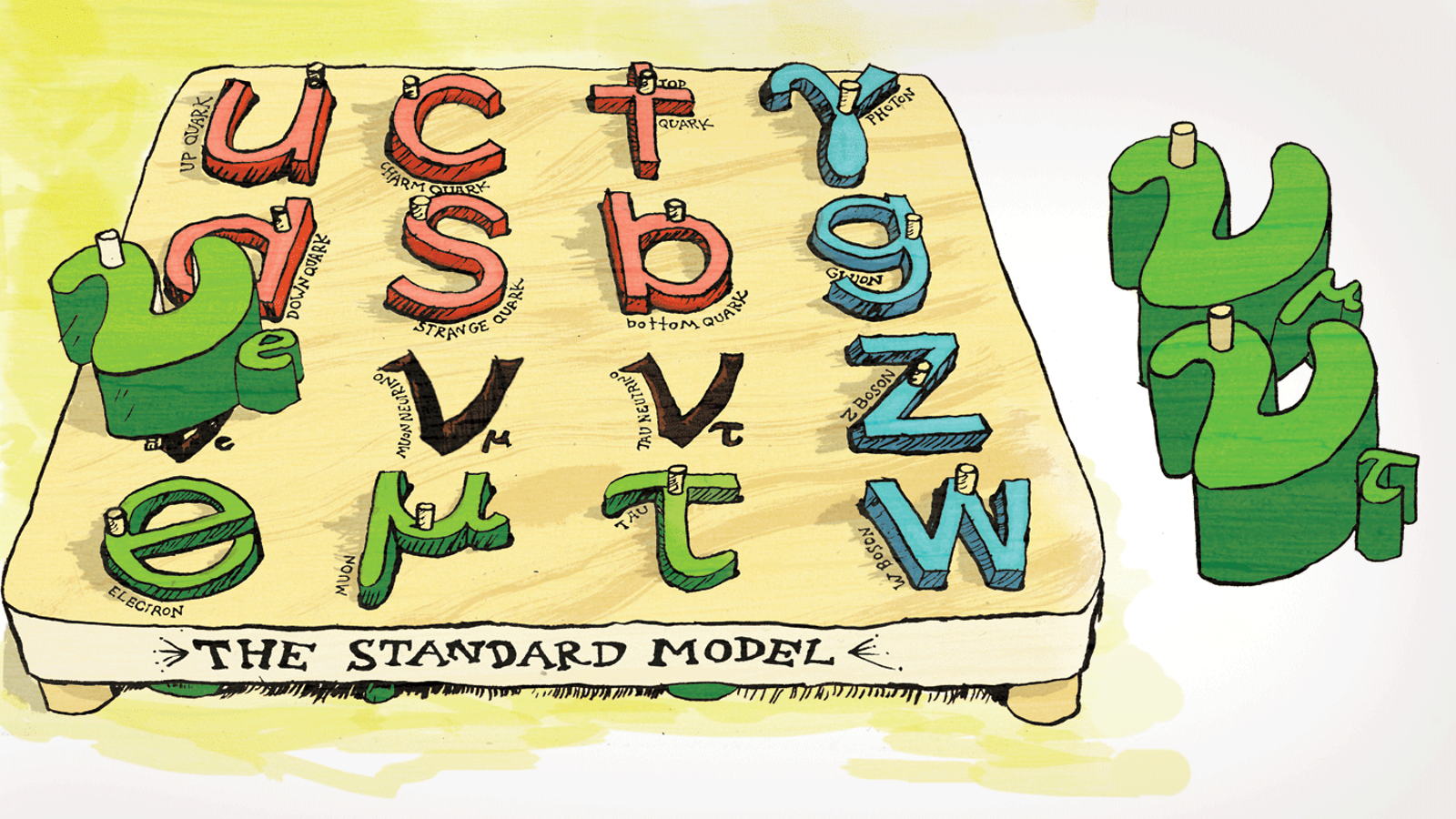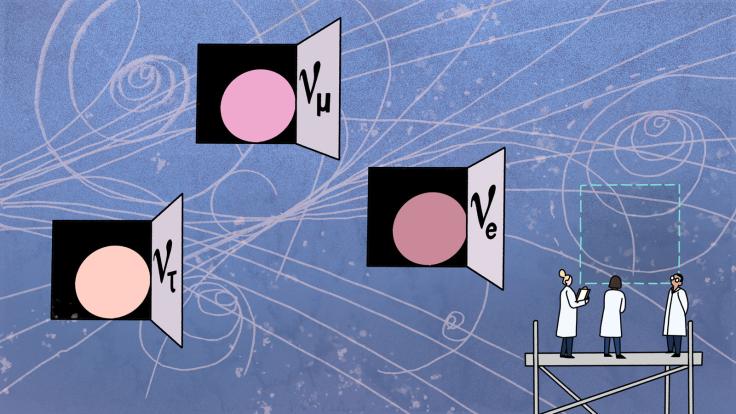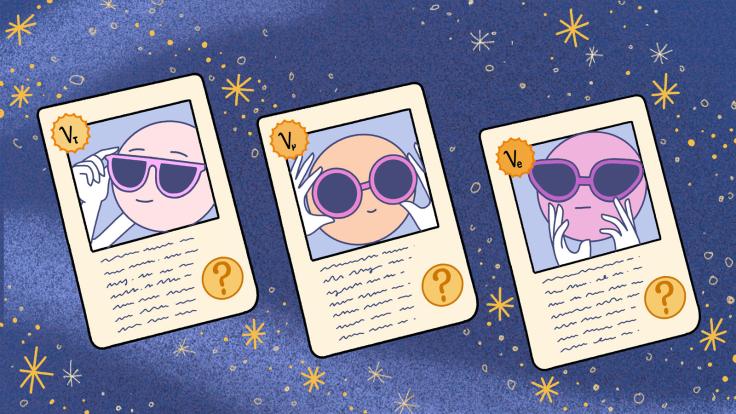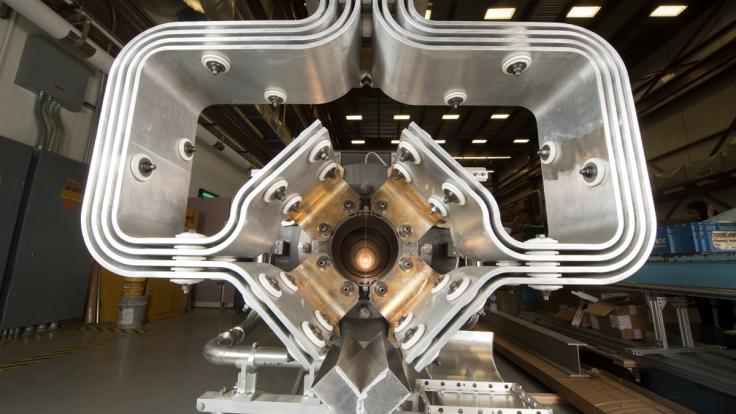Neutrinos are as mysterious as they are ubiquitous. One of the most abundant particles in the universe, they pass through most matter unnoticed; billions of them are passing harmlessly through your body right now. Their masses are so tiny that so far no experiment has succeeded in measuring them. They travel at nearly the speed of light—so close, in fact, that a faulty cable connection at a neutrino experiment at Italy’s Gran Sasso National Laboratory in 2011 briefly led to speculation they might be the only known particle in the universe that travels faster than light.
Physicists have spent a lot of time exploring the properties of these invisible particles. In 1962, they discovered that neutrinos come in more than one type, or flavor. By the end of the century, scientists had identified three flavors—the electron neutrino, muon neutrino and tau neutrino—and made the weird discovery that neutrinos could switch flavor through a process called oscillation. This surprising fact represents a revolution in physics—the first known particle interactions that indicate physics beyond the extremely successful Standard Model, the theoretical framework that physicists have constructed over decades to explain particles and their interactions.
Now scientists are gearing up for new neutrino studies that could lead to answers to some big questions:
If you could put neutrinos on a scale, how much would they weigh?
Are neutrinos their own antiparticles?
Are there more than three kinds of neutrinos?
Do neutrinos get their mass the same way other elementary particles do?
Why is there more matter than antimatter in the universe?
The answers to these questions not only offer a window on physics beyond the Standard Model, but may also open the door to answering questions about the universe all the way back to its origins.
Nature vs. machine
When it comes to finding neutrinos to study, scientists have three choices.
They can catch naturally occurring neutrinos, such as the ones produced by nuclear reactions in stars like our sun, in collisions of cosmic particles with Earth’s atmosphere or in stellar explosions known as supernovae. Stars like our sun produce electron-flavor neutrinos, while cosmic particles and supernovae produce a mixed bag of all three neutrino flavors and their antineutrino counterparts.
Alternatively, scientists can investigate neutrinos made in the nuclear reactors that generate power for homes and businesses. Reactors produce electron-flavor antineutrinos. Experiments to study neutrinos from this type of source require the construction of a particle detector near a nuclear power plant and yield valuable information about neutrinos and their interactions with matter.
Finally, scientists can deliberately produce neutrinos for experiments by firing protons from an accelerator at pieces of graphite or similar targets, which then emit specific types of neutrinos. Accelerator experiments have the advantage of being able to examine either neutrinos or antineutrinos. The intense beams of these accelerator-made particles increase the chance for a neutrino interaction to occur in detectors. In addition, accelerators can produce neutrinos that have higher energy than those emerging from reactors and the sun. That makes accelerator experiments extremely valuable in determining the exact nature of neutrinos.
The two types of manmade neutrino sources have another advantage: Detectors can be placed at specific distances from the source, depending on the science to be done. The optimal distances can range from tens of meters to a few hundred kilometers for reactor experiments and hundreds to thousands of kilometers for long-baseline oscillation experiments that use neutrinos from accelerators.
For example, the planned Long-Baseline Neutrino Experiment, which will use an existing accelerator at Fermi National Accelerator Laboratory, will have a detector situated at what former LBNE Spokesperson Bob Svoboda calls “the sweet spot”—a place just far enough away that neutrinos should have close to maximum mixing of their flavors by the time they hit the detector. “From this, we can learn a great deal about how neutrinos change,” says Svoboda, who is a professor at the University of California, Davis. And since LBNE will produce both neutrinos and antineutrinos, physicists can explore the differences between matter and antimatter interactions and what they might mean for the imbalance between matter and antimatter in our universe.
Catch them if you can
Neutrino detectors also come in a variety of flavors. Since neutrinos themselves are invisible to detectors, scientists must take an indirect approach: They record the charged particles and flashes of light created when a neutrino hits an atom, and thus infer the neutrino’s presence.
Because the tiny neutrino interacts with matter so rarely, the only way to detect it is to put lots of matter in its way. Super-Kamiokande, a now-classic neutrino detector in Japan, is filled with 50,000 tons of water. Neutrinos—produced in Earth’s atmosphere, coming from the sun and generated by an accelerator 295 kilometers away—interact with water molecules and produce charged particles. In turn, these particles produce blue flashes called Cherenkov radiation. Light sensors within the water tank capture and record the glow.
The new NOvA detector, under construction in Ash River, Minnesota, advances SuperK’s technology. Instead of water, NOvA will use liquid scintillator—a chemical that flashes as particles pass through—to observe neutrinos fired at the detector from Fermilab, about 800 kilometers away. At more than 60 meters long and 15 meters tall, NOvA will be one of the largest plastic structures in the world.
Instead of using one large tank filled with liquid, the NOvA detector is highly segmented to glean more information about each incoming neutrino’s identity and energy. The 14,000 tons of liquid scintillator will be divided among hundreds of thousands of tubes made of PVC plastic, says Fermilab’s Pat Lukens, a project manager for the experiment. When a neutrino hits a nucleus in the detector, producing charged particles and flashes of light, researchers will be able to tell precisely where the interaction occurred and which way the particles went.
Another technology for getting more information about neutrino interactions is a grid of wires submerged in a detector liquid. Placed under high voltage, the wires attract charged particles that appear when neutrinos interact with the liquid. This technique, employed in the ICARUS neutrino detector in Italy, reveals the precise tracks of the charged particles produced when neutrinos interact in liquid argon. For the much larger LBNE detector, to be located at the Sanford Lab in South Dakota, scientists are designing the next generation of this type of detector.
The next steps
The results of recent neutrino experiments have opened the door to learning much more about neutrinos and their habits. In 2011, researchers turned on the first set of detectors at the Daya Bay Reactor Neutrino Experiment in southern China, hoping to make a key measurement that would help them understand how one type of neutrino turns into another.
In March 2012, after only seven months of taking data, the Daya Bay scientists announced success: They nailed the measurement of theta one-three, one of three so-called “mixing angles” that describe the oscillation of neutrinos between one flavor and another. Previous experiments had shown that theta one-three had to be small, and scientists had begun to wonder whether this mixing angle might be zero. The Daya Bay result, in combination with other neutrino measurements in Japan, South Korea, France and the United States, showed that the angle is small, but definitely not zero.
When the size of that angle was announced, neutrino physicists from around the world cheered. The result opened up the possibility that neutrinos behave differently than antineutrinos, which in turn might help explain the preponderance of matter over antimatter in the universe.
This leaves scientists in a good position to learn more about one of the most abundant and ubiquitous particles in the cosmos. New neutrino oscillation experiments “have a good shot of reaching their goals,” says Boris Kayser, a theorist at Fermilab. Using the theta one-three result, they could determine the neutrino mass hierarchy and find out whether neutrino interactions violate the matter-antimatter symmetry. These are crucial steps toward understanding whether neutrinos are the reason for the dominance of matter over antimatter in our universe.
The most difficult question to answer, Kayser says, is “What are the unknown unknowns?” While physicists have some expectations about what they will see, neutrinos again and again have proven themselves difficult to predict. Given their bizarre nature, it’s entirely possible that neutrinos may hold many more surprises for scientists down the line.
Through experiments that use a range of approaches and technologies, physicists are beginning to get a fuller picture of neutrino behavior. The results could be key to answering questions that have stymied scientists for years.
Experiments have shown that neutrinos have a tiny, nonvanishing mass. Although each neutrino must be a million times lighter than an electron, their exact masses are not known. Due to their abundance, neutrinos could account for several percent of the mass of the universe and play a significant role in the evolution of the universe.
The frequency of neutrino oscillations depends on the mass difference among the three different neutrino types. The NOvA experiment will soon begin to send neutrinos from Fermilab to Ash River, Minnesota, a distance of 810 kilometers. Scientists hope that the observation of the resulting oscillations will determine which type of neutrino is the heaviest and which is the lightest.
Discovering this mass hierarchy is the first step. To complete their understanding of neutrino masses, scientists also need to determine the absolute neutrino mass scale by measuring the mass of one of the neutrino types. The KATRIN experiment in Germany will attempt to do just that. The experiment will study the nuclear decay of tritium, an unstable form of hydrogen. It will compare the mass and kinetic energy of particles before and after the decay, which produces an electron antineutrino. Because the total energy of all particles involved in the decay must be preserved, scientists can determine the mass of the antineutrino if they can measure the kinetic energy of particles with sufficient precision.
Scientists have observed the interactions of both neutrinos and antineutrinos with matter. But it is not clear whether a neutrino and its antiparticle are two separate particles. In the case of charged particles, scientists easily can distinguish particles and their antiparticles by their electric charge. An electron has negative charge, and a positron has positive charge. Neutrinos, however, have no electric charge. So it’s possible that a neutrino could be its own antiparticle. Theorists refer to this case as the Majorana neutrino, in honor of Italian physicist Ettore Majorana, who recognized this possibility. Alternatively, neutrinos and antineutrinos could be separate particles and behave according to the equations developed by theorist Paul Dirac.
Several nuclear experiments, including the Enriched Xenon Observatory in New Mexico and the Majorana experiment in South Dakota, aim to settle the Majorana-vs.-Dirac neutrino question. They are examining radioactive nuclei that exhibit the simultaneous decay of two neutrons—a process known as double beta decay and first observed in 1986. This nuclear reaction normally ejects two antineutrinos, which carry away energy from this decay process.
If the Majorana theory is correct, the two antineutrinos would also be neutrinos, and they could “cancel each other out.” The result would be the occasional neutrinoless double beta decay, in which neither neutrinos nor antineutrinos are emitted. If experiments observed this rare process, it would confirm the Majorana theory and pave the way for many elegant theories that explain how neutrinos acquire mass and why their mass is so much smaller than that of any other particle of matter we know.
The Standard Model describes only three neutrino flavors, each linked to the electron or one of its heavier cousins via the weak nuclear force—the fundamental force responsible for radioactive decay and the production of neutrinos. But a variety of evidence suggests that additional neutrino flavors may exist, with properties quite different from the three known types of neutrinos. Experiments will continue to look for these “sterile” neutrinos, which get their name from the fact that they do not interact with other matter through the weak force, as other neutrinos do.
According to the Standard Model, the field associated with the Higgs boson provides quarks and charged leptons—a group of elementary particles that includes the electron—with mass. However, many scientists think the masses of the ultra-light neutrinos arise, at least in part, in some other, yet-unknown way. Experiments at the Large Hadron Collider, which discovered a Higgs-like particle, won’t be able to measure neutrino properties. Instead, future nuclear experiments and neutrino oscillation experiments such as NOvA and the Long-Baseline Neutrino Experiment could weigh in on the origin of the neutrino masses. “LBNE and NOvA could help us to interpret the results of those nuclear experiments,” says Boris Kayser, a theorist at Fermilab.
According to physicists’ current understanding of the big bang, matter and antimatter formed in equal amounts when the universe began. But if that were the case, every last smidgen of matter should have collided with every last smidgen of antimatter by now. This would have released lots of energy and filled the universe with light and radiation, but left it without any matter at all. “Why isn’t the universe entirely energy?” asks Kayser. “Why didn’t the matter and the antimatter annihilate each other as soon as they were made?”
The answer to that question lies in something called charge-parity symmetry violation. Finding the right kind of CP violation to explain the preponderance of matter is a top priority, and neutrinos are prime candidates. “It’s often called the Holy Grail of neutrino physics,” says Mark Messier, co-spokesperson of the NOvA experiment and a professor at Indiana University.
Previous studies found CP violation—a difference in the behavior of particles and their antiparticles—among elementary particles known as quarks. But this CP violation does not explain the overall matter-antimatter imbalance.
Neutrinos come into play because their incredible lightness suggests, through a theory called the “see-saw picture,” that they are the ultra-light relatives of very heavy particles that lived briefly in the early universe. The disintegration of these heavy particles may have violated CP symmetry in a way that led to the present-day imbalance between matter and antimatter. If that is indeed how the imbalance arose, then scientists should also find CP violation in the oscillation of today’s neutrinos.



















